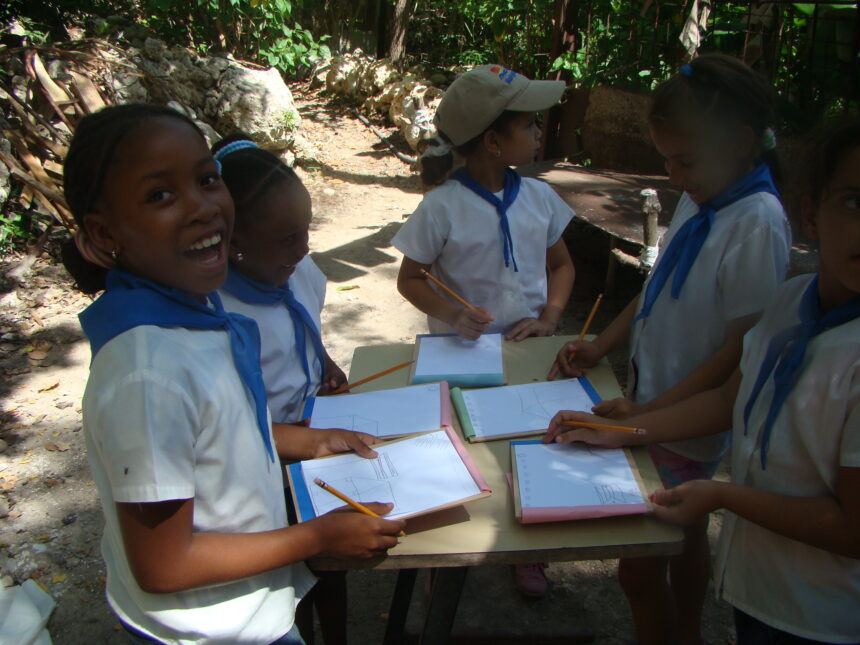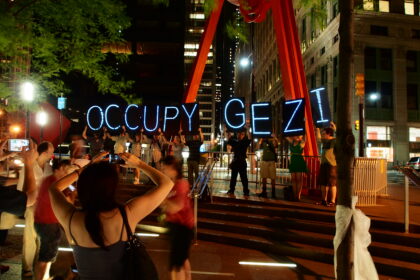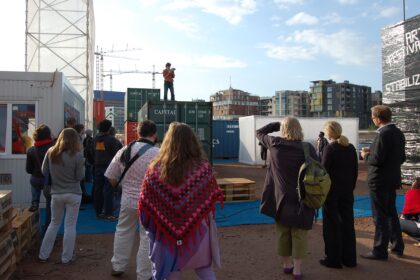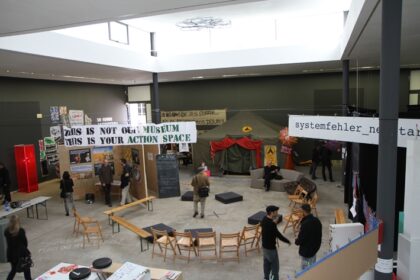Socially engaged practices within La 12 Bienal de La Habana, May-June, 2015
Paloma Checa-Gismero
Between May 22nd and June 22nd, 2015, the 12th edition of the Bienal de La Habana was open to the public in the Cuban capital. Over seventy-five venues hosted a number of projects fitting under the umbrella of the biennial’s title: Between Idea and Experience. The purpose, to highlight processes of urban transformation active in Havana, as well as to defend the space for socially aware ethics within the discourses of global contemporary art. The experience, a permanent travelling through the city, from venue to venue, between a number of different urban sites, changing frameworks and reminding oneself that regardless of how well constructed the architecture of an art biennial is, it always happens in a place that was already there.

[Image 1. Echando lápiz, a drawing workshop in the community of Casablanca. Credits: Graciela Duarte, Manuel Santana]
Entering the Casa de las Américas, a friendly receptionist walks you up to the second floor, where you’re welcomed by a gallery assistant eager to discuss with you the details of Luis Camnitzer’s multiple Exercises, instances of his contribution to this year’s Bienal de La Habana, a workshop on the basis of conceptual art. On view, around sixty ephemera items produced by workshop attendees at the Bienal’s inaugural day, May 22nd, 2015. This time Camnitzer, who has been exploring art’s pedagogical value for a long time and has been a permanent presence through multiple iterations of the Bienal de La Habana, seems to defend a more hands-on approach to learning about art through its practice. For instance, in his show, Exercise #3 reads: “Choose any word and add to it the suffix ‘ism’. In not more than a page, write a manifesto stating the goals and purposes of that philosophical-aesthetic movement. Design a flyer for the text and assure proper distribution of this manifesto so as to gather the biggest amount of followers possible, both creators and consumers.”
However, this emphasis in practice as source of knowledge is not exclusive to Camnitzer’s work. In its 12th edition, the Bienal’s title was “Between Idea and Experience”. Accordingly, its catalog essays drew an exhibition’s anchoring terminology that pointed to the value of community relations as grounding loci for art processes: the plural first person ‘we’, its role as both art’s makers and audiences, the importance of social movements and neighborhood relations in art making, global margins and non-Western imagined worlds, transversality, ethics, and inter-disciplinarity. But the ideas put forward by biennial curators as parameters of action for the exhibition do not necessarily translate in form and content to all of the artworks displayed in this year’s iteration. La Bienal de La Habana featured a mixture of white cube like exhibitions and a variety of proposals that, unrelated to the constrictions of a gallery space, sought to direct visitors’ attention to the lives of Havaneros and the multiple instances of transformation that the Cuban capital is undertaking in the present.
The ideas elaborated in the catalog are more evidently present in the multiple community based projects curated for this year’s edition spreading through different areas of the Cuban capital. Initially part of the Bienal’s program, the Museo Orgánico Romerillo opened in the neighborhood of Romerillo, West of Vedado. In addition to its central venue, Museo Orgánico Romerillo includes family houses, parks, bus stops, streets, walls, and multiple community places, and turns them into exhibition spaces for works by local artists working in different types of media. Slowly adopting the identity of a neighborhood center, since its opening on May 2015 this project has gathered media attention, thus achieving a remarkable notoriety in the Cuban capital. Led by well-known artist Kcho, the museum engages a sizable number of neighbors and local cultural producers into the celebration of workshops, community dinners, music performances, and the reception of national and foreign academics as well political figures such as Cuban President Raúl Castro. Museo Orgánico Romerillo is an interesting case of socially engaged art project that, despite breeding from an institutional critique tradition, does not position itself in opposition to the sources of political power, but accommodates its action in a decades long tradition of state-sponsored community centers.
Another of the works that inserted itself in the city’s mesh was Echando lápiz, an 8 years long project by Colombian artists Graciela Duarte and Manuel Santana that brought its last iteration to Havana. Hosted in a local family house, Echando lápiz consisted of a month-long series of drawing workshops, gathering community members and artists to wander the streets exploring the city’s autochthonous vegetation. These conversation based events forged community relations and the recognition of neighbors’ knowledge about the properties of wild urban plants in particular and, more broadly, their immediate citiscape. Echando lápiz also shared a venue with Puno MoCA, a reconsideration of what constitutes a museum, by Peruvian born-Florida based César Cornejo. Built on a small scale exchange economy of its own, Puno MoCA employed community members into performing several museum duties: remodeling rooms in a family house to be turned into exhibition spaces, working as gallery assistants, and building large-scale sculptural interventions. How can a state sponsored art biennial enter the private space of a family house? These two works reflect on this conundrum during the duration of the Bienal. Also in the district of Casablanca, Venezuelan architecture collective Colectivo Pico Studio moved temporarily to an empty street lot for their project Acupuntura urbana, a series of conversations on low-tech collaborative architectural actions, involving specialized and non-specialized local agents into the picturing of imagined solutions to some of the city’s most urgent urban problems.
As part of the exhibition Entre, dentro, fuera / Between, inside, outside, Mexican artist Pedro Lasch held a workshop on the nature of biennials. Linked to his work Islas de tragedia y fantasía, a commentary on art’s lasting critical potential in the format of banners, a three day-long workshop problematized the differences between natural and cultural disasters, pointing to a discussion on the multiple discursive frameworks that overlap in an art biennial. Participants in the workshop dealt with issues of collective memory, social justice, pressing urban needs, collective and individual desires, and the representation of tragedy. Structuring conversation over round tables and small discussion groups, the artist orchestrated a dialogue involving city planners, biennial visitors, school teachers, art students, local and world-known artists, biennial curators, neighbors, and culture officials. At the end of this workshop its venue was opened to be programmed by workshop participants. The rich and fruitful nature of the initial discussion was however tamed when exhibition purposes required its concretion in objects and images, an alteration of discourse that is indicative of the separation between public and private realms of speech operating in Cuban society.
Luis Camnitzer had long ago incorporated in his practice the programmatic character of art that bred out from the upheaval of the first and second avant-gardes. This feature became as well integrated into the biennial as form, and some of these big exhibitions have acquired an unquestionable experimental character, as do the workshops led by the Uruguayan conceptual artist, Colombians Graciela Duarte and Manuel Santana of Echando lápiz, the team behind Museo Orgánico Romerillo, and Pedro Lasch’s workshop. All of these pieces push blackon the Bienal de La Habana’s declared attempt to showcase the reality of a city. They propose new forms for this portrayal, forms that may only be successful during the duration of the biennial. They underline the necessity of learning through making and chatting. They speak of exceptional utopian instances of a global contemporary art world pursuing its own ethical reform, and in so doing they engage with a city, its buildings, and its people.
Paloma Checa-Gismero is an art critic. She works towards her PhD in Art History, Theory and Criticism at UCSD.











